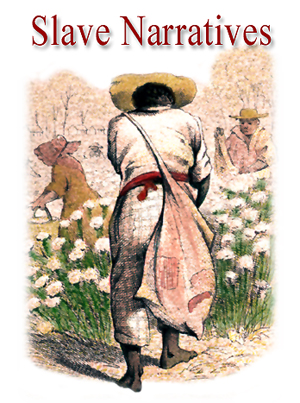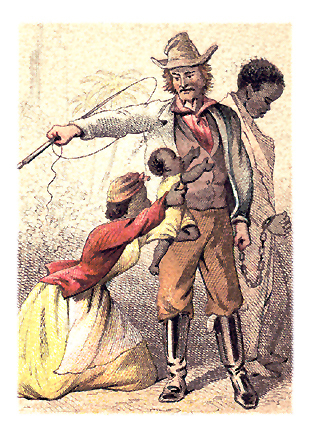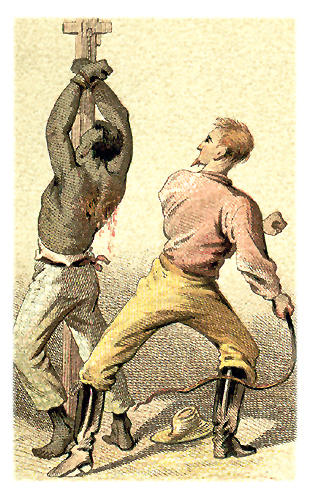Slave Narratives: William Wells Brown's Narrative of a Fugitive Slave
 |
William Wells Brown was a prominent author, lecturer and historian of the mid-nineteenth century. Born into slavery and eventually gaining his freedom, he used his experiences from his time in bondage to establish a career in writing and lecturing.
Even when the Constitution allowed for slavery, religion justified it, and society accepted it, Brown spoke out against the horrific practice, utilizing literature and speech as powerful tools against slavery. Hired by the American Anti-Slavery Society, he worked closely with famous abolitionists including William Lloyd Garrison and Wendell Phillips to help pioneer the field of African American literature and speech. The Narrative of William W. Brown: A Fugitive Slave, Written By Himself is his most popular narrative and is acclaimed for its straightforward and unadorned writing style and his often frank emotionally detached recounts of his experiences as a slave. His story provides a window into the cruel and bizarre practice of slavery as the events throughout the piece give a testimony against the institution of slavery. Brown’s narrative serves as a first hand testimony of the key ideas and practices that abolitionists of the time opposed and were eager to exploit. Like in Frederick Douglass’ Narrative of the Life of Frederick Douglass, an American Slave and countless slave narratives like it, Brown’s accounts of his servitude, escape, and life after freedom offer more than just an entertaining story. In addition, they also tell of the plight of slavery as a whole, recounting events and emotions experienced by the masses. He personalizes the practice, giving the perhaps naïve or uninformed reader, a glimpse into the lives and mindset of slaves both in the context of his own personal experience, as well as the institution as a whole. The
increased popularity of slave narratives during the
nineteenth century stemmed from the fact that readers could
study first-hand accounts of the horrors of slavery and, in turn,
create a powerful tool for abolitionists.
William Wells Brown’s abolitionist editors, Edmund Quincy
and J C Hathaway, not only edited and wrote prefaces for his
text to give it credibility and appeal but, in addition,
they were hoping that his work would help instigate readers
to Brown
takes no time to prepare the reader for the harsh realities
of slavery; he begins his narrative by immediately and
bluntly telling how he was born in Lexington, KY then stolen by
his master. He then goes on to cite that, at a very young age,
he witnessed his mother being whipped in the field.
Brown candidly recounts how he woke up one morning to hear
the sounds of his mother being whipped for being a few
minutes late to the field, explaining “I
could hear every crack of the whip, and every groan and cry
of my poor mother. I remained at the door, not daring to
venture any farther. The cold chills ran over me, and I wept
aloud. After giving her ten lashes, the sound of the whip
ceased, and I returned to my bed, and found no consolation
but in my tears. It was not yet daylight”(Brown, 16). Moreover, throughout his work Brown espouses slavery’s dehumanizing effects, telling of the horrors of the system and the wrongs that it forces humans to commit. Like Frederick Douglass in his “Fourth of July Address,” Brown reveals the contradictions of the institution as he highlights hypocrisy of a society that allows for the exploitation of human labor while, at the same time, declaring its own Christian goodness. After being whipped mercilessly by a cruel master he explains how “The man who but a few hours before had bound my hands together with a strong cord, read a chapter from the Bible, and then offered up prayer, just as though God sanctioned the act he had just committed upon a poor panting, fugitive slave”(Brown, 73). This example of a master’s abuse of religion shows a practice universal throughout the institution of slavery and personalizes it within Brown’s account of his life, providing more fuel for abolitionists.
Likewise, throughout this work, Brown highlights how the institution of slavery often turns good moral people, including himself, corrupt. Most memorably Brown recounts a situation in which he exploited a fellow slave so that he, himself, would not have to be punished. Afterwards he explains that, “This incident shows how it is that slavery makes its victims lying and mean… I have often, since my escape, deeply regretted the deception I practiced upon this poor fellow; and I heartily desire that it may be, at some time or other, in my power to make him amends for his vicarious sufferings in my behalf”(Brown, 58). To justify this act, Brown explains that the situation illustrates the meanness and brutality that slaves would have to resort to under the horrible system. Furthermore, Brown tells of how he was hired by his master to work in the slave trade; essentially supporting the very practice that ruins lives, destroys families and causes pain to himself and his family and friends. One of the most dehumanizing tasks that he had to carry out was preparing slaves for market and traveling with slave traders despite begging to his master to allow him to work somewhere else. He describes how he was “heart-sick at seeing [his] fellow-creatures bought and sold”(Brown, 43).
Brown’s narrative is an excellent addition to a broad field of slave narratives and abolitionist literature. He speaks for the masses and voices the opinions and atrocities experienced by a lot of slaves of the time. He focuses on specific incidents and events to tell his story and lets the reader draw their own opinions and conclusions from the events and his work. The narrative ends optimistically with Brown beginning his new life as an abolitionist and leaving the reader profoundly moved by his triumphs and heartaches, as well as, with anger and incredulity at the institution of slavery. [Not for reproduction without permission of the author] |
Images: Library of Congress, [LC-DIG-ppmsca-05453] Bibliography: 1. Andrews, William L. ““The First Century of Afro-American Autobiography: Notes Toward a Definition of a Genre.” To Tell a Free Story. Urbana & Chicago: Univ of Ill. Press, 1986. 2. Carter, Linda M. “William Wells Brown (1814-1884).” African American Autobiographers: A Sourcebook. Ed. Emmanuel S. Nelsonl. Westport, Conn: Greenwood Press, 2002. 55-60. 3. Douglass, Frederick. Narrative of the Life of Frederick Douglass, an American Slave. New York: Penguin Group (USA) Inc. 1982 4. Douglass, Frederick. The Frederick Douglass Papers. Series One: Speeches, Debates and Interviews: Volume 2: 1847-54. Ed. John W. Blassingame. New Haven: Yale University Press. 1982. 5. Jefferson, Paul. “The Autobiographical Writings of William Wells Brown.” Masterpieces of African-American Literature. Ed. Frank n. Magill. New York: HarperCollins, 1992. 13-17. 6. Yellin, Jean Fagan. “William Wells Brown.” The Intricate Knot: Black Figures in American Literature, 1776-1863. New York: New York University Press, 1972. 152-81. 7. “William Wells Brown." Wikipedia, The Free Encyclopedia. 10 Jul 2006, 17:24 UTC. Wikimedia Foundation, Inc. 24 Oct 2006 . |
HISTORY ARTICLES
- ART DECO CARS
- Queen Victoria & Royalty
- Aesthetic Movement
- Women of the Gilded Age
- Emily Dickinson
- Mark Twain
- FINGER LAKES HISTORY
- Abigail Adams
- Uncle Tom's Cabin
- Slave Narratives
- Native Americans
- Civil War Reenacting
- Civil War Sanitary Fair
- Civil War Soldiers
- Civil War Troops
- Augusta's Victorian Heritage
- Southern Needlework
- Atlantic City Beach
- Coney Island
- Sea Islands Hurricane
- San Francisco Earthquake
- Montreal Carnival
- Winter Carnival
- Magic Lantern Shows
- Victorian Theater
- Irish Political Cartoons
- History of Golf
- St. Andrew's Ladies Golf
- Great Exhibition
- William Morris
- 19th Century Carriages
- Ghissi Altarpiece

 “understand slavery better and to hate it
worse”(Jefferson,14). Brown conforms to this genre of
abolitionist African American literature with frequent
accounts of the inhumanities that he endured and discussions
of events that represent slavery as an institution rather
than as an individual experience.
“understand slavery better and to hate it
worse”(Jefferson,14). Brown conforms to this genre of
abolitionist African American literature with frequent
accounts of the inhumanities that he endured and discussions
of events that represent slavery as an institution rather
than as an individual experience.  His story continues on this vein, openly recounting
the horrific realities and brutalities of slavery. Brown
relates how he was beaten mercilessly and suffered horribly
from hunger and cold, not sparing the reader any of the
shocking detail and often explaining the cruelties frankly
and complacently with little emotion.
His story continues on this vein, openly recounting
the horrific realities and brutalities of slavery. Brown
relates how he was beaten mercilessly and suffered horribly
from hunger and cold, not sparing the reader any of the
shocking detail and often explaining the cruelties frankly
and complacently with little emotion. Despite
the misery and sense of hypocrisy that Brown may have felt,
this was his task and like many others he must have faced,
he detached himself emotionally. Brown does not seem to hold
himself or the individuals who carried it out responsible,
but instead blames the situation and institution of
slavery. Perhaps he feels that he has made up for these
acts later with his work in abolition and helping to smuggle
fugitives to freedom in Canada through his work on the
riverboats.
Despite
the misery and sense of hypocrisy that Brown may have felt,
this was his task and like many others he must have faced,
he detached himself emotionally. Brown does not seem to hold
himself or the individuals who carried it out responsible,
but instead blames the situation and institution of
slavery. Perhaps he feels that he has made up for these
acts later with his work in abolition and helping to smuggle
fugitives to freedom in Canada through his work on the
riverboats. 